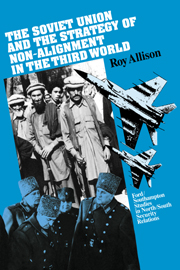Book contents
- Frontmatter
- Contents
- Acknowledgements
- Introduction
- 1 The Soviet view of non-alignment in the international order
- 2 The Soviet Union and the search for international security by the non-aligned states
- 3 Soviet policy and neutralisation in the Third World
- 4 Soviet policy and military alignment in the Third World
- Conclusion
- Notes
- Select bibliography
- Index
2 - The Soviet Union and the search for international security by the non-aligned states
Published online by Cambridge University Press: 15 December 2009
- Frontmatter
- Contents
- Acknowledgements
- Introduction
- 1 The Soviet view of non-alignment in the international order
- 2 The Soviet Union and the search for international security by the non-aligned states
- 3 Soviet policy and neutralisation in the Third World
- 4 Soviet policy and military alignment in the Third World
- Conclusion
- Notes
- Select bibliography
- Index
Summary
SUPERPOWER CONFLICT PREVENTION
A central objective of the Non-Aligned group of states in the 1960s was to secure a more stable international environment through eliminating the sources of regional and global conflict, dampening down existing conflicts and providing against their resurgence. From its inception the Non-Aligned group was ill-equipped to deal with disputes between states in its midst. The non-aligned states instead directed their energies outwards towards reducing tensions and averting disputes threatening Great Power hostilities. At the Belgrade Non-Aligned Conference in 1961 Jawaharlal Nehru argued that whenever there arises ‘a crisis involving the possibility of war the very fact that we are unaligned should stir us to action’. In its initial phase the strategy adopted by the Non-Aligned to deal with the dangers posed by Great Power rivalry had three major components: the encouragement of negotiations between the superpowers and where possible the creation of a non-aligned communication link between them, strengthening collective security arrangements at the global and regional levels, and work for general and complete disarmament. The Soviet attitude to the first two tasks will be examined here; the disarmament question will be treated separately.
In the early 1960s Soviet spokesmen encouraged the non-aligned states to pursue this ambitious agenda and promoted their influence in international affairs. Soviet officials were impressed by the growing weight of the non-aligned countries in the overall global constellation of power.
- Type
- Chapter
- Information
- Publisher: Cambridge University PressPrint publication year: 1988



